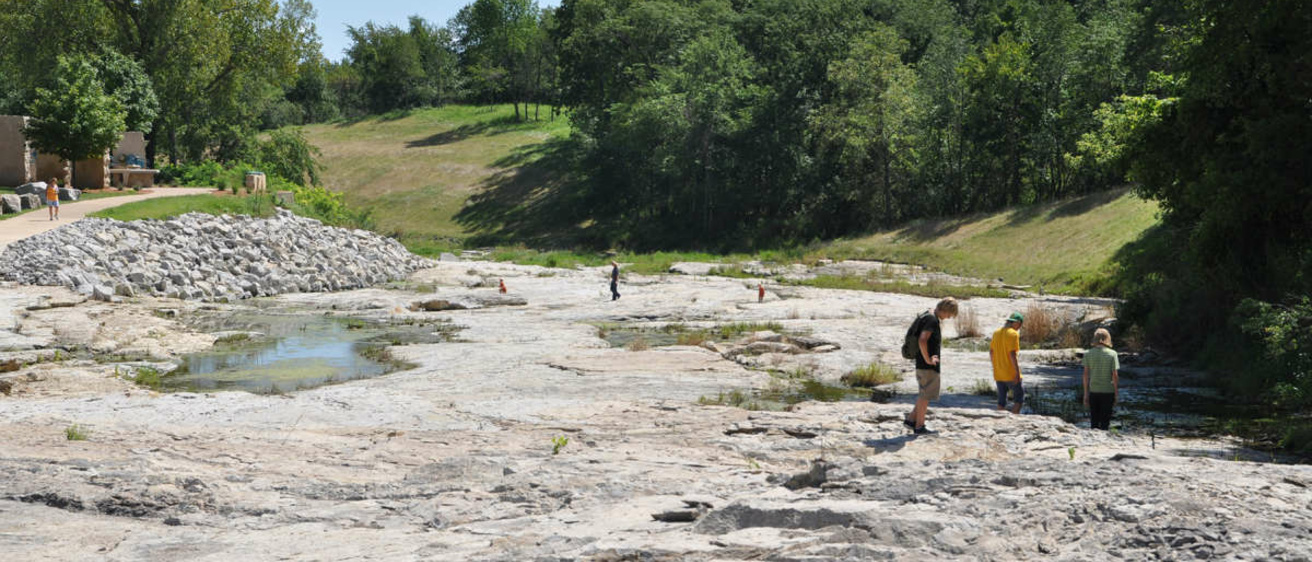Main navigation
The Devonian Age
A time when Iowa was swathed in warm, shallow waters and home to creatures like trilobites, brachiopods, and the earliest fish. The fossil remains of these ancient Iowan inhabitants (over 375 million years old!) can be seen firsthand by visitors at the Coralville Devonian Fossil Gorge, where floodwaters in 1993 & 2008 stripped away heavy layers of soil and vegetation, exposing the remains of this ancient ocean floor.
Natural processes of wind, rain, snow, and ice cause weathering and erosion. But most importantly at the Devonian Fossil Gorge, flooding has the power to transform what fossils are exposed in the rock. . . thus, the annual conditions of Iowa are always changing the landscape, and sometimes cause fossils to disappear. Please be aware when you visit the Gorge that things may not be the same as what you see here—but then again, this means there's always the chance to see something new!
Attention
There is no personal fossil collecting in the gorge! Thank you!
Contact us
Hours are typically 6am—10pm daily; call ahead for more information & campsite reservations.
Address: 2850 Prairie Du Chien Rd NE, Iowa City, IA 52240
Call: (319) 338-3543 ext. 6300
Virtual tour
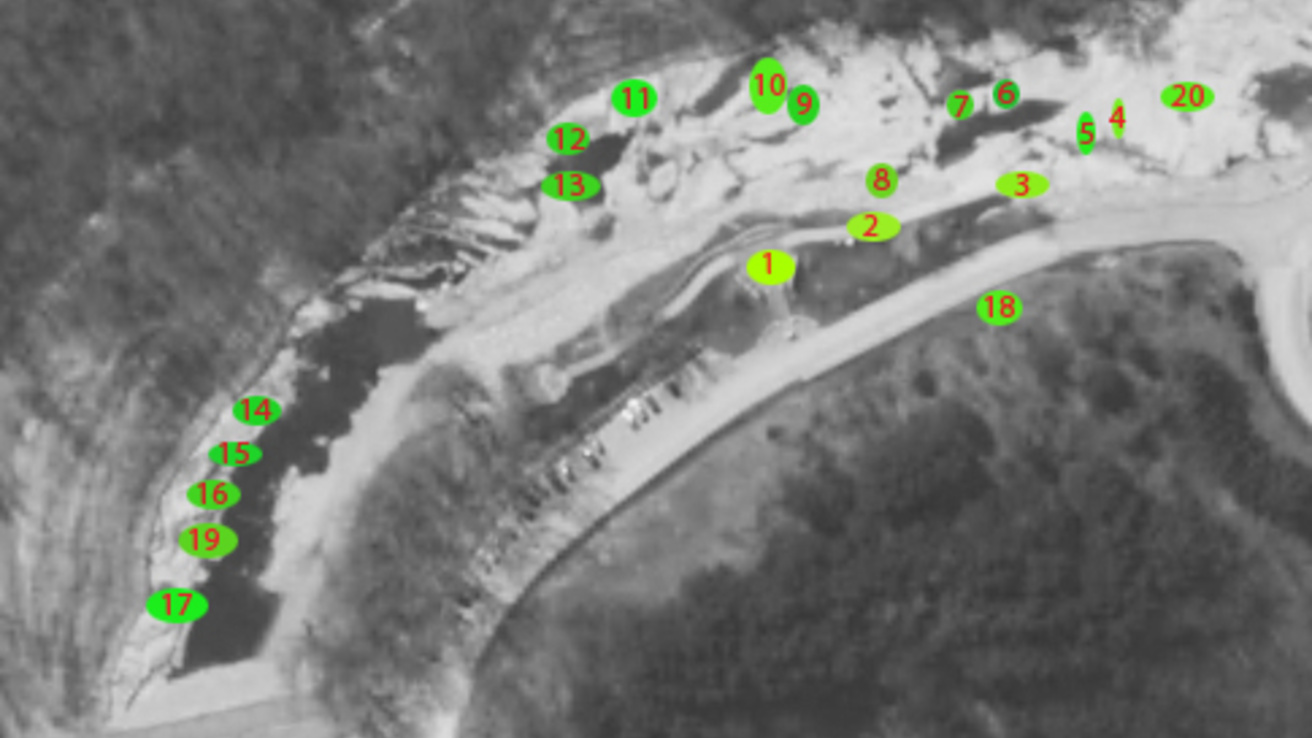
Focus zones
- Entry Plaza
- Devonian Limestone
- Lower Rapid Biostrome
- Crinoid Fossils
- Long Crinoid Stem
- Various Fossils
- Calcite Filled Fracture
- Trilobite Fossil
- Cave Collapse
- Karstified Surface
- Brachiopods, and Differential Weathering
- Pothole and Coral
- Imbricated Slabs
- Old River Sediments
- Brachiopods, Folds, and Fractures
- Fault
- Abundant Fossils
- Upper Rapid Biostrome
- Chert Nodules
- Fault Slickenslides
Video tutorials
Focus point #1: "Entry Plaza"
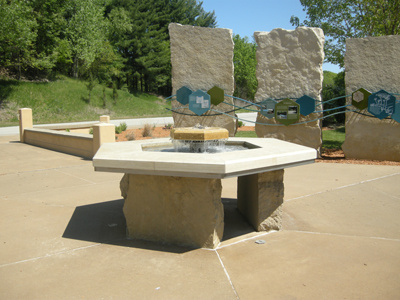
The entrance to Devonian Fossil Gorge displays information about geology, paleontology, original environment, and recent history of the Gorge. The hexagonal display plates on the large slabs of Silurian dolomite echo the structure of fossil corals found in the Gorge. This is the main landmark at the gorge that guests can use as a marker when looking for the other features within the gorge. Pick up a self-guided tour leaflet here, or collect one from the Visitor Center at the other end of the dam.
Focus area #2: "Devonian Limestone Boulders"
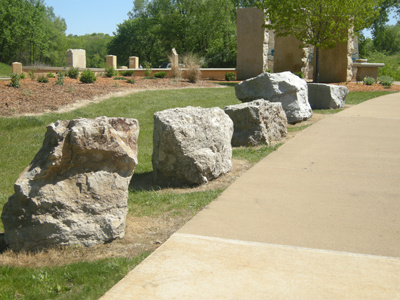
These are the rocks that make up the bedrock around eastern Iowa. They’re from the Devonian Period (416 to 345 million years ago). Limestone is a bioclastic sedimentary rock made from calcite (CaCO3) derived from the shells, skeletons, and other hard parts of marine animals. As this calcite builds up on the seafloor, it is compacted, and cemented by organisms, developing limestone. The rocks of the Devonian Fossil Gorge, and bedrock visible around the Iowa City-Coralville area are the remains of this ocean sediment. Iowa’s Devonian limestone is used today as aggregate for roads, and as building material. The Old Capitol Museum in Iowa City and many other buildings on the University of Iowa Campus are made from local Devonian limestone.
Focus site #3: "Lower Rapid Biostrome"
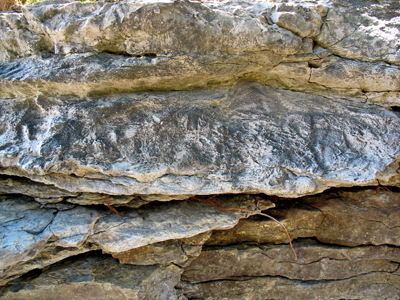
A biostrome is a layer in a rock made almost entirely of fossils. In this biome there is a distinct layer of the fossil corals Hexagonaria and Favosites. Stromatoporoid sponges and brachiopods also make up this biostrome. This particular biostrome layer extends all over the U. S. Midwest and is roughly one hundred miles wide. When viewed closely you can see the colonial structure of the corals and see where each soft-bodied polyp once lived. The biostrome is part of the Cedar Valley Limestone Group that outcrops across the northern to east-central side of Iowa.
Focus site #4: "Crinoid Fossils"
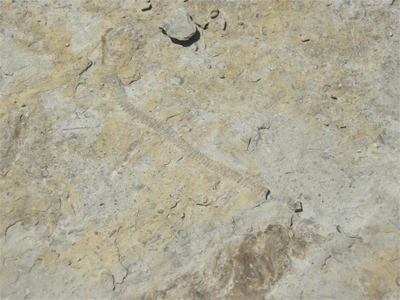
Crinoid fossils are some of the most abundant fossils at the Gorge. Crinoids (also called sea lilies) are marine animals that live attached to the sea floor or other substrates or live freely in the water. They are related to starfish and sea urchins and belong to the animal phylum Echinodermata. Their columnal stalks are the easiest way to identify them. In the photo shown you can see the stem and calyx, but the crinoid’s arms (smaller frond-like stalks) are not visible. They use their arms to capture nutrient particles in the water column, and direct the to their mouth in the calyx. Like all echinoderms, they have a water vascular system. Crinoids were abundant during the Devonian, and still live in today’s oceans. Look out for articulated stems, sometimes leading to calyxes or tiny “donuts” that are the individual plates that make up the stem. A new genus of crinoid was discovered at the Gorge in 1993.
Focus point #5: "Long Crinoid Stem"

This crinoid stem is over a foot long and is preserved in a curved position. This suggests that the crinoids must have been buried very rapidly before they could be broken up by currents and animals, or disarticulate by decaying on the sea floor.
Focus site #6: "Various Fossils"
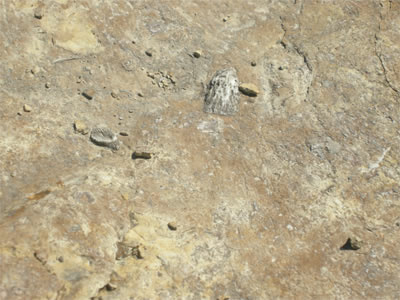
There are many brachiopods and crinoid fragments here, but the most obvious fossils are rugose (Order Rugosa) corals. These are also known as horn corals because they grow in the shape of a horn. Rugose corals are extinct and have a different composition from modern corals. Rugose corals which grew in solitary and sometimes colonial forms. You can see other coral mound-shaped corals at the Gorge that are colonial rugose corals (see focus zones #3 and #12). In the photo shown you can see the top of the coral or calyx. This is where the soft-bodied animal resided. Features of the calyx structure are used to identify the fossil species.
Focus zone #7: "Calcite Filled Fracture"
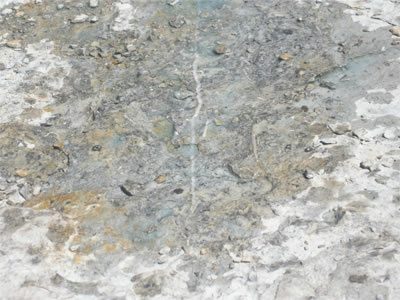
A thin, light grey line can be traced almost all the way across the Gorge rocks. This is a fracture in the limestone that has been filled with an evaporite deposit of calcite. Most likely what happened is that water containing dissolved calcite covering existing fractured Devonian rock evaporated in an arid climate, leaving behind the calcite. Iowa is rich in such evaporite deposits due to the shallow seafloor environment that existed during the Devonian. For example, there is a large gypsum mine in Burlington Iowa. Gypsum is an evaporite mineral used in the making of drywall.
Focus zone #8: "Trilobites"
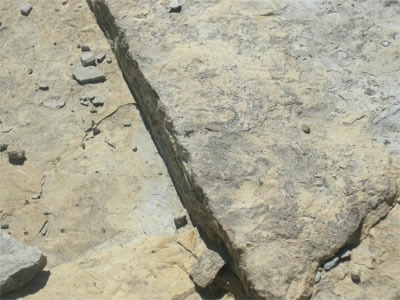
This particular trilobite belongs to the Family Acastidae, subfamily Asteropyginae. Common within Cedar Valley Limestone found around Iowa City and Coralville, this species is identifiable by its unique tail. Trilobites were highly abundant during the Devonian, and belong to the animal phylum group Arthropoda. Modern arthropods include lobsters, spiders, insects, and crustaceans. This picture only shows the tail of the trilobite (center), which is surrounded by crinoid stems and brachiopods. Trilobites were epifaunal specimens that preyed on various seafloor organisms.
Focus zone #9: "Cave Collapse"
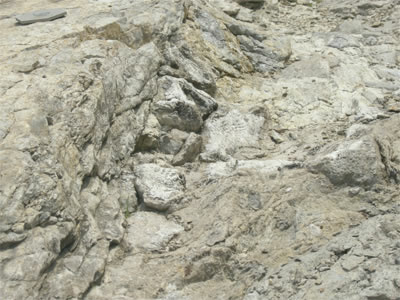
This is an ancient cave that was once under sea. Colonial corals (composed of tiny, individual organisms that live connected to each other) thrive primarily in shallow seas where sunlight is abundant, so we know that there wasn’t always a cave here enclosing these organisms. As the Gorge eroded, the top of this cave was exposed for us to discover a prehistoric scene: we can determine that it had been an abrupt collapse upon the once-living corals, likely creating a sinkhole as the underwater cave’s roof toppled in.
Focus zone #10: "Karstified Surface"
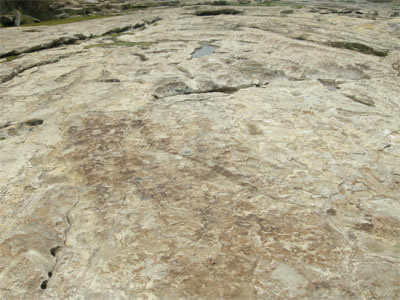
A karst is an area of irregular limestone where erosion has produced fissures, sinkholes, underground streams, and caverns. In this region of the gorge, a cavern formed as groundwater dissolved part of the limestone through a chemical weathering process called karstification. Limestone is made from calcite, which it is very soluble… as groundwater dissolves it beneath the surface, sinkholes and underground caverns are formed. The openings in the picture show how karstification has affected the limestone beds. There is also an extension of the cave shown on the top left of the image. These dark, slot-like caverns are very wide, but not very deep: they are only a few inches tall.
Focus zone #11: "Brachiopods and Differential Weathering"
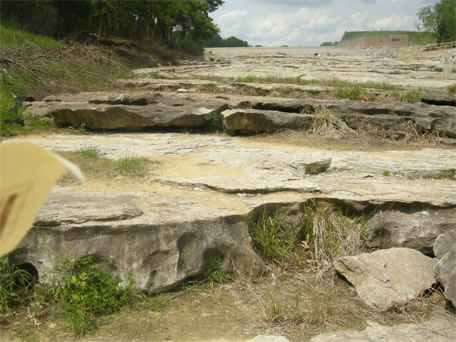
Notice the stair-like pattern that stretches across the gorge; this is a result of differential weathering. The clay-rich basal rock erodes faster than limestone; groundwater movement thus erodes unevenly, sometimes creating cave-like openings and indentations.
Focus zone #12: "Pothole and Coral"
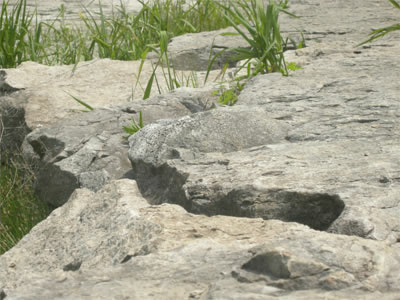
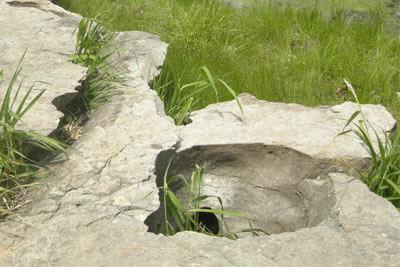
This is another example of a karst. The hole was formed through karstification of the limestone, and near it is also one of the largest Hexagonaria colonial corals that can be seen at the gorge. Hexagonaria corals are very common in the limestone bedrock along the Iowa River. . . Coralville, IA was named after the vast abundance of these coral fossils found in the area. As part of the phylum Cniderea, Hexagonaria corals differ from Rugose (horn) corals, which are not a colonial coral species.
Focus zone #13: "Imbricated Slabs"
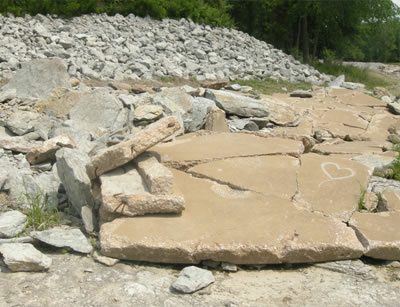
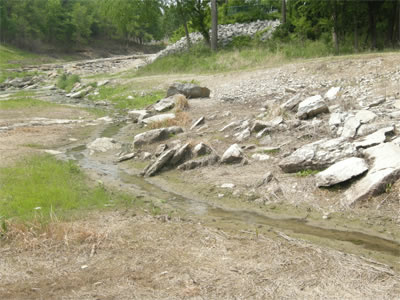
Here, overlapping rock slabs dip into the path of a stream. These slabs were placed here by rushing flood waters. The “dip” (tilted angle) can show which direction the flood waters flowed.
*The tan rocks on the left are not limestone, nor natural—they are concrete slabs held together by steel re-rods and deposited here by the flood’s destruction. The steel re-rods should not be interpreted as fossils. They may look like crinoids stems but they are not to be interpreted as fossils.
Focus zone #14: "Ancient River Sediments"

This is a mound of rust-colored sand and gravel, originally deposited by an ancient river. It still remains here because a large slab of limestone was used as an overly to protect it from floodwaters. Rivers have what is called a competence and a capacity. Competence is the maximum grain size it can carry, which increases with velocity and is always at its greatest in times of flood. The capacity is the maximum load it can carry; this increases with the amount of moving water (aka the “discharge”). Rivers can carry all types of grain sizes: ions, silt, gravel, and even up to large boulders, depending on their discharge. ‘Ions’ are the smallest particle type; these are carried in what is known as the “dissolved load.” They dissolve from percolating groundwater seep into streams, which are then readily carried in small amounts until precipitated by chemical change. Next are ‘small grains’— which include clay and silt, in what is known as the suspended load. Small grains are carried within water until they are deposited as the river’s discharge decreases enough to let them drop down. Most river sediments are carried in this suspended load— such as the silts and clays shown in this image. The final load a river may carry is called the “bed load.” In this case, larger, denser grains (like gravel, sand, and sometimes boulders) are dragged along the bottom of the river. Too heavy to really be 'carried,' these larger grains instead bounce along the bottom of the river in a process known as saltation.
Focus zone #15: "Brachiopods Folds and Fractures"

At this point in the gorge is a large fold* in the rock layer; this serves as a narrative display of the previous stresses placed upon these rocks millions of years ago during the Devonian. Fractures in the limestone occur as the rock breaks in a manner that's not along one of its weaker cleavage planes. It takes a lot of force to fracture a rock, thus the large scale of fractures seen in this picture reveal a great amount of previous tectonic force. Brachiopod fossils abound inside the rock folds; these creatures are similar to crinoids, because both are sessile (immobile), benthic epifaunal, and filter feeders—but the two do not belong to the same phylum. Brachiopods have a bivalve shell and a pedicle that attaches to the sea floor, and while they may look like clams, they are unrelated. Clams are in the phylum molluska, while brachiopods are in the phylum brachiopoda. The major characteristic of a brachiopod that separates it from being a mollusk is its pedicle (every brachiopod has one). Spinatrypa and Spinifer species of brachiopods can be found at this location in the gorge.
Focus zone #16: "Faults"
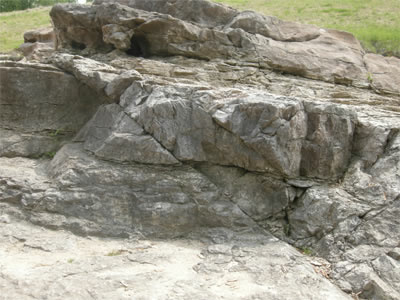
The large diagonal cross-cutting lines in these rocks represent ancient fault zones. Fault zones occur when tectonic plates spread apart or draw together. Stress forces from tectonic activity cause strain on the rocks, resulting in earthquakes. (But the gorge’s faults are now inactive, so you should be safe!). Notice the down-dropped limestone on the left of the fault line; structural geologists use this to understand that this particular Devonian fault was a “reverse fault”— the foot wall is moving downward, while the head wall is moving upward. This produced compressional stress.
Focus zone #17: "Abundant Fossils"
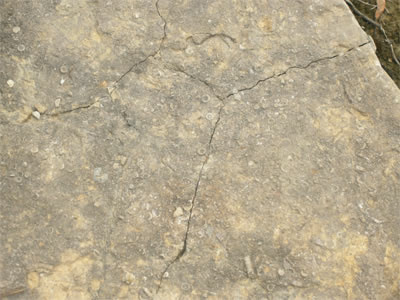
Here are abundant small horn corals, brachiopods, and crinoid stem fragments; most common are the columnar crinoids, which look like circular discs in the rocks. The small holes in the center of these discs are their water vascular systems, (which classifies them in the animal phylum Echinodermata). This array of fossils shows what Devonian shallow seafloor communities looked like; and the closely clustered fossils also illustrate how crowded these communities really were.
Focus zone #18: "Upper Rapid Biostrome"
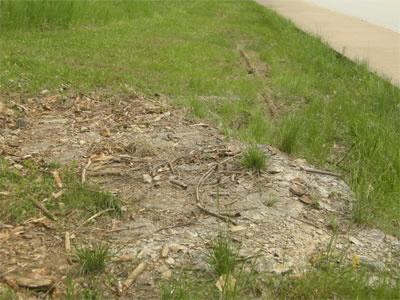
Here is another example of a biostrome—these are exciting layers in the stratigraphy which are completely composed of fossil material. The biostromes that this site is a part of can be traced over 150 Miles (from Southeast Iowa to Southern Minnesota). (To see the gorge’s lower biostrome, check out Focus Zone #3 above).
Focus zone #19: "Chert Nodules"
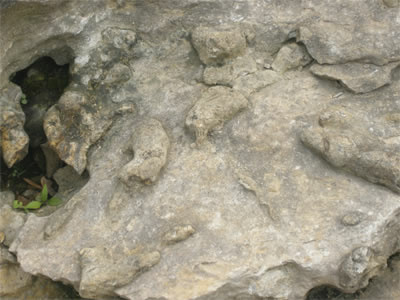
These irregular shapes are chert nodules. Chert is the replacement mineral to limestone. Here, it is a form of microcrystalline quartz SiO2, which formed as the calcium carbonate of the limestone was replaced with silica through a chemical process called diagenesis. Diagenisis is a change in physical and chemical properties of the sediment—in this case, calcite—between the times of deposition and solidification.
Focus zone #20: "Fault Slickensides"

Here we can see fault slickensides on the surface of the limestone. These are grooves formed from plate movement as the plates grind past each another. Notice the grooves on the exposed rocks; this rock has been polished, scratched, and worn down by different rock from the other side of a fault. This example is further proof of the tectonic activity that took place in Iowa during the Devonian, millions of years ago.
Devonian Fossil Gorge Website. Content by Jeffrey Miller (UI BS 2013).
Supported by Paleontological Society Outreach Award.
